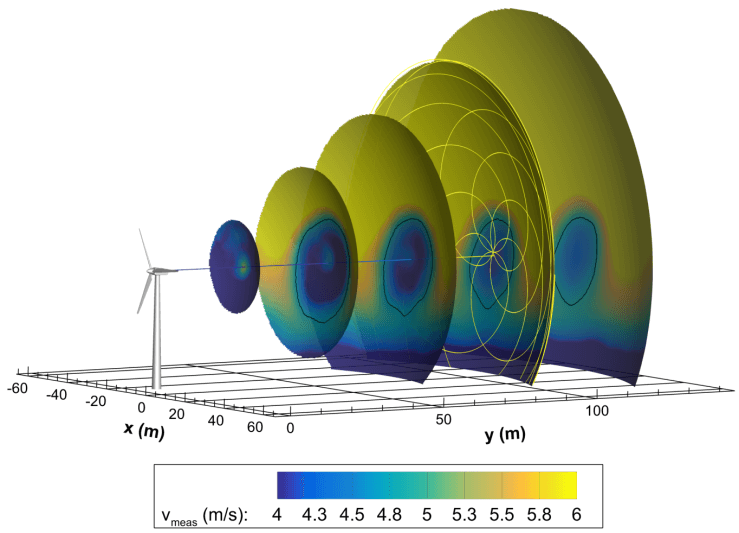A team of researchers at Sandia National Laboratories (SNL) and the National Renewable Energy Laboratory (NREL) are planning a critical experiment at Sandia’s Scaled Wind Farm Technology (SWiFT) Facility to investigate the use of wind turbine yaw control to direct wakes, a promising approach to increase power production in wind plants. During the multi-month field campaign, researchers will collect data to improve both high-fidelity wind plant simulation software and demonstrate novel control concepts. Industry could then develop advanced controllers for deployment in commercial wind farms to increase power production.

A screen capture from an animation depicting the SpinnerLidar scanning pattern at the SWiFT site overlaid on velocity profiles extracted from virtual lidar simulations
The animation depicted in the above screen capture was created from the virtual LIDAR (i.e., light detection and ranging) model and computational fluid dynamics (CFD) simulation to depict the LIDAR scanning pattern that will be used for the Wake Steering Experiment. The video depicts one of the SWiFT turbines operating in real time and scale while the DTU SpinnerLidar scans a rosette pattern at five distances downstream (1 – 5 rotor diameters). The contour surfaces at each scanning distance represent the average line-of-sight velocity interpolated from the SpinnerLidar virtual model interrogation of the CFD simulation, estimating the resolution of experimental data that can be expected. The black irregular shape at each distance represents the output of an image-processing method used to determine the center of the wake produced by the turbine. This wake location in time and space will be a key data set to assess and improve the wake steering control model, one of the primary objectives of the experiment. All data from the upcoming experiment will be made public through the DOE Atmosphere to electron (A2e) Data Archive Portal for other researchers to analyze for their own models and tools. See more on the Wake Steering
Filed Under: News





Better mixing downstream can also be accomplished with a much larger free flowing center on a a wind turbine. According to Von’s law, if the working blades are canted downstream, the air velocity is increased by the flow around of nature, which will increase the energy output of the turbine with less actual working blade area. Other benefits are also achieved: better storm and gust survival, less load on yaw mechanism, and better bird survival.